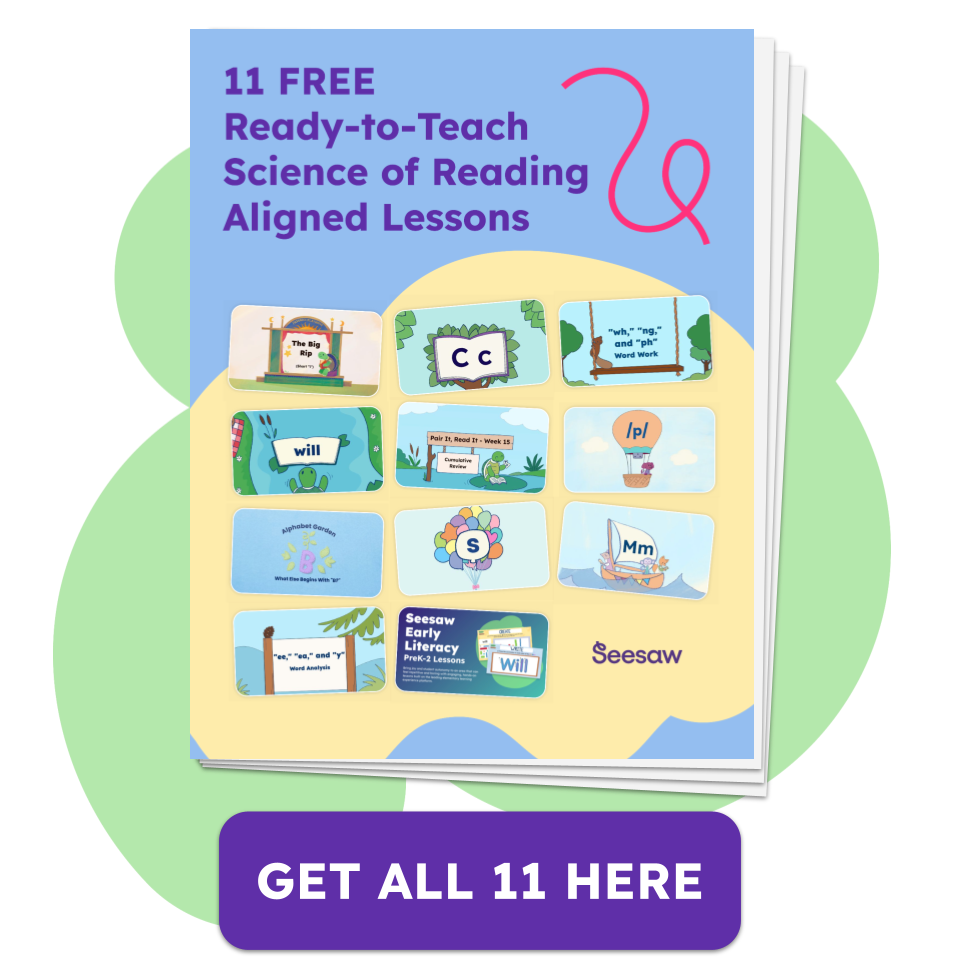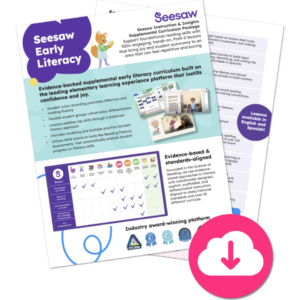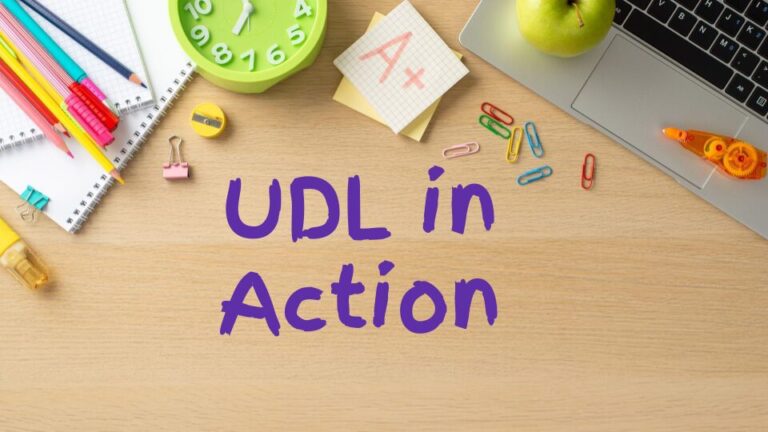Literacy is one of the most critical foundational subjects for elementary students. Our youngest learners must get high-quality, evidence-based, equitable instruction that allows them to succeed in school and life. Early literacy is the foundation of acquiring language through listening, speaking, reading, and writing. Literacy knowledge encourages academic achievement, lifelong learning, active citizenship, and equitable participation in our 21st-century society.
In recent years literacy has received even more attention from educators, public policy, and government – putting it in the spotlight for many districts. A lot of this new attention comes from the post-pandemic effects we have seen in reading & literacy data; students are behind grade-level in this critical, foundational area. Moreover, there have been recent movements highlighting the lack of evidence backing popular reading programs. At this critical time, many schools and districts are looking into their literacy programs and looking for evidence-backed, research-based solutions for early literacy.
Word Recognition
Word recognition is invaluable in learning to read as it enables swift and accurate identification of words, fostering fluent reading and comprehension. Proficient word recognition leads to reading fluency, allowing readers to focus on understanding the text rather than slowing down to decode individual words. Additionally, it contributes to vocabulary development by exposing readers to a diverse range of words encountered in text, promoting language enrichment. Purposeful practice of word recognition skills is more important than ever. With proficient word recognition, readers gain independence and confidence in reading, leading to increased engagement and enjoyment of reading. Overall, word recognition serves as a foundational skill that empowers readers to navigate texts with ease, unlocking the doors to enjoyment and lifelong learning. Given evidence-back strategies, educators can effectively support children’s development of phonological awareness, decoding skills, and sight word recognition–all components of word recognition–laying a strong foundation for reading success.
Strategies to Improve Students Word Recognition
- Rhyming: Engage children in rhyming and rhyming games where they identify words that rhyme. This helps develop their awareness of phonemes and sound patterns.
- Segmenting and Blending Sounds: Have students practice segmenting words into individual sounds and blending sounds together to form words.
- Syllable Segmentation: Encourage children to clap or tap out the syllables in words. Start with simpler words and progress to more complex words as children develop proficiency.
- Phoneme Manipulation: Have children manipulate phonemes within words by substituting, adding, or deleting sounds.
Decoding:
- Phonics Instruction: Provide systematic and explicit phonics instruction, teaching children the relationship between letters and sounds.
- Word Families: Teach children to recognize common word patterns or word families Have them practice decoding words within the same word family to reinforce phonics skills.
- Decodable Texts: Use decodable texts that contain phonetically regular words aligned with the phonics skills children are learning. Encourage children to apply their decoding skills while reading these texts.
- Word Building Activities: Engage children in word building activities where they manipulate letter tiles or magnetic letters to form words. Encourage them to blend the sounds together to read the words they create.
Sight Word Recognition:
- Word Walls: Create word walls with high-frequency sight words that children encounter frequently in text. Encourage children to practice reading and spelling these words regularly.
- Flashcards: Use flashcards to practice sight word recognition. Review a set of sight words daily and have children read the words aloud or spell them.
- Contextual Reading: Encourage children to identify sight words within the context of sentences or short passages. Provide opportunities for them to practice reading sight words in meaningful contexts.
- Games and Activities: Incorporate games and activities that reinforce sight word recognition, such as sight word bingo, sight word memory match, or sight word scavenger hunts.
Language Comprehension and Development
Developing language skills early is critical for academic success and lifelong achievement, serving as the foundation for literacy growth. Oral language skills such as segmenting and blending sounds are strong predictors of word reading abilities. In addition, a robust vocabulary helps children to determine meaning from written text. Achieving optimal language development depends on access and opportunities to practice verbal interactions. From adult conversations and caregiver-child exchanges to content encountered on platforms like YouTube, children are exposed to various sources as models that develop their language skills. Early literacy is the foundation of acquiring language through listening, speaking, reading, and writing.
Strategies for Language Comprehension and Development:
- Build Background Knowledge: Provide ways for students to build background knowledge through exposure to diverse texts, experiences, and discussions. Activate their prior knowledge before reading.
- Explicitly Teach Vocabulary Instruction: Teach vocabulary explicitly and systematically, focusing on tiered vocabulary words that are essential for comprehension. Use evidence-based strategies such as semantic mapping, word webs, and context clues to deepen understanding of vocabulary words.
- Demonstrate Language Structures: Implement structured literacy approaches that integrate phonology, syntax, and semantics, and more in a systematic and explicit manner.
- Expose Students to Verbal Reasoning: Engage children in text-based discussions to deepen comprehension and critical thinking skills. Encourage students to ask and answer questions about the text, make inferences, make connections to their own experiences, and support their ideas with evidence from the text.
- Broaden Students Literacy Experiences: Develop literacy knowledge by teaching concepts such as print concepts, genres, and text structures. Use scaffolded instruction to build upon children’s existing literacy knowledge and support their development as proficient readers and writers.
Early Intervention and Assessment
Early intervention and assessment ensure students growth is on track leading to long-term academic success and overall development. Identifying and addressing growth opportunities at an early age can lead to more effective outcomes and stronger interventions. Research shows that early intervention has long-term benefits for children’s academic achievement, social-emotional development, and overall well-being.
Strategies for Implementing Early Intervention and Assessment:
- Regularly Screen and Assess: Use evidence-based screening and assessment tools to identify ways to support students. Certain tools can assess various aspects of early literacy development, including phonological awareness, phonics, fluency, vocabulary, and comprehension.
- Embed Observational Assessments: Conduct ongoing observations of student’s literacy behaviors and interactions with literacy materials in various contexts, such as during free play, small group activities, or reading time. Observational assessment provides valuable insights into children’s strengths, challenges, and progress in literacy development.
- Involve Parents or Caregivers: Engage parents and caregivers in the assessment process by providing information about early literacy milestones, offering opportunities for parent-teacher conferences, and encouraging home-based literacy activities. Collaborating with families ensures a holistic approach to supporting children’s literacy development.
- Progress Monitor: Implement ongoing progress monitoring to assess student growth and determine the effectiveness of interventions. Use formative assessments, such as curriculum-based measurements, to track students’ progress over time and make data-informed instructional decisions.
Teacher Friendly, Research Validated Early Literacy Solution
Seesaw’s supplemental curriculum is validated by LearnPlatform, a third-party edtech research company, to satisfy Level IV requirements according to Every Student Succeeds Act (ESSA). The programs systematic evidence-based practices and explicit instruction of phonological and phonemic awareness, phonics, oral reading fluency, vocabulary, and reading comprehension align with research-based practices to accomplish this task. Read the full report outlining how Seesaw satisfies this validation here.
Say Hello to Seesaw
Seesaw provides evidence-based early literacy content that can be implemented flexibly while instilling a love of reading. We support foundational reading skills with engaging, meaningful, standards-aligned lessons that bring joy and student autonomy to any classroom. Say goodbye to boring, repetitive, drill-based programs, and say hello to Seesaw.
Try out the following collections, which also include formative assessments, to support your students in literacy:
- Fun Phonemes, also offered in Spanish, helps students build phonemic awareness by listening to, identifying, and matching sounds to build mastery of each phoneme.
- Alphabet Garden introduces learners to letters where they practice letter formation, phonemic awareness, and making connections to each letter in the real world.
- Alphabet Treasures assists students in building rapid letter recognition and identification in multimodal ways.
- Phenomenal Phonics, also offered in Spanish, helps students recognize sound-spelling relationships by sorting, blending, segmenting, and making connections.






